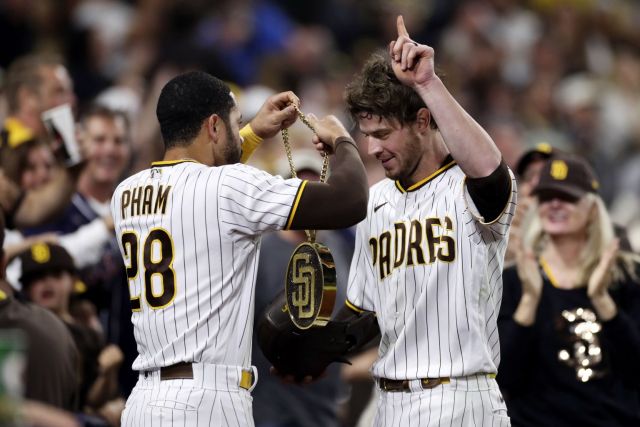-
Posts
21452 -
Joined
-
Days Won
82
Content Type
Profiles
Forums
Downloads
Everything posted by Yankee4Life
-
Friday in baseball Aaron Judge called a player’s-only meeting a day after team owner Hal Steinbrenner placed the blame squarely on the players instead of on Brian Cashman or Aaron Boone. Screw him. This meeting should have been called in May and not now. But I do hope it helps. Another good night for your favorite and mine Shohei Ohtani. The ass kissing tour for this guy added a few more bandwagoners after last night’s Angel win. Props to Marlins pitcher Pablo Lopez for dealing with Braves #1 hot dog Ronald Acuna, Jr. You almost wish a Yankee pitcher would have the guts to deal with Rafael Devers the same way. Speaking of Devers just watch him the next time you watch the Red Sox via your MLB account. Whoever taught that guy how to show off in front of the cameras did it well. Again with the vertigo crap Clint Frazier? Someone went 0 for 4 for an eastern Pennsylvania team to drop his average to .270. Thirty million dollars a year for this? The Seattle Mariners have 44 wins, or twenty more than they were expected to have by this time in the season.
-
It was their fault for letting him go.
-
Who else is talking in this thread right now but you and I? If someone has something to say about a game last night or one of tonight's match-ups then they should jump in. No big deal. Posts will not be ignored if they have nothing to do with the Yanks. And Gordo I am talking directly at you right now. Nothing seems to be good enough for you. First it was a big problem with what you saw as bitching, complaining, moaning, etc about the Yankees and you didn't like that. Now after talking about a roster move they made and who should be traded you have a problem with that. There was no bitching, complaining or moaning there. Just questioning out loud why they went out and got another right-handed bat. I've toned down the disgust that I have for this team. I still have it and after the way they lost to the Angels the other night I even have more of it at the moment. But it makes no sense for me to come in here night after night to remind people how I feel about them right now. Regulars of the forum know exactly how I feel about this team and it isn't good. So I am damned if I complain and scream about them and damned if I don't. Why don't you just concentrate on critiquing the Phillies broadcasting team and not worry about if the Yankees are talked about or not?
-
I accept that and if i were them I would begin to trade away players but not for a quick fix but rather for the long haul. Judge should be the first to go and I don't accept that guy being the face of the franchise. Well, then again maybe he is and that is why so much work needs to be done in order to be a competitive team again. You HAVE TO start somewhere.
-
I’m wondering if Gardner won’t last the month now that Tim Locastro is here? Honestly I don’t care. Get rid of the crap on the roster. Yes, getting Andujar away from the outfield will help. He also could be trade bait. Why not? This team is going nowhere and that’s just how it is.
-
Kind of seems to me that the Yankees are trying to find the next Mike Tauchman. That's all well and good but did they need another right-handed hitter?
-
I don't believe they use a DH when he is pitching. Yeah I agree. The Yankees would have tried to make him throw left-handed.
-
Angels designated hitter Shohei Ohtani hits a home run during the fifth inning of an 11-5 loss to the New York Yankees on Tuesday June 29, 2021. Luke Voit makes a close play at first.
-
Because it's Sanchez. That should explain everything.
-

My Mlb 2K12 Stuck In Career Mode In Game 20 Of Season Two
Yankee4Life replied to chachi's topic in Support
English only please. And this is a nine-year-old thread. -
An update on Josh Naylor right here. Cleveland Indians OF Josh Naylor has fracture, dislocation of right ankle after gruesome injury Sunday
-

Random Thoughts On A Sunday Morning Updated To 11-23
Yankee4Life replied to Yankee4Life's topic in Left Field (Off-Topic)
What I remember about them getting Stanton was that they just got out of a ten year contract with Alex Rodriguez and they tie themselves up with another one? I honestly believe they got him so he could tattoo the ball off of the Green Monster in Boston. Good idea but he has to actually hit the ball first. I'm not a follower either but when I read that article about her I had to write about it. She'll be the only counselor who will sell you nude photos of herself. I'm lucky because when I was growing up no one liked Nugent so therefore we didn't listen to him. To this day I don't listen to him nor care what he has to say. That is not to say I was happy to find out that he caught Covid. I wasn't. That is nothing to mess with. But I do notice that since he got the virus and recovered he has suddenly been quiet. -
That right there is the root of all their problems. They're trying to re-invent the wheel with these young players by turning them into something they are not instead of bringing out what they have and using it.
-
No bitching, griping or calling out players today who have not played well. There is no point. I think by now everyone can see, if you can pardon the expression, the bloom is off the rose when you are talking about this particular squad making a statement when October rolls around. It’s just how it is and while I am not happy about it -believe me that is the mother of all understatements- the way they are playing has not affected anything else I have going on in my life. I’m not sitting in a room with the blinds closed moaning at the TV. It’s summertime and I am enjoying every day of it which means there are a lot of things to do and see. It’s fun being outside even if you are out on your back deck catching a nice breeze. And as far as I know no baseball team that I know can mess that up.
-
I run my mods on an old XP laptop and they work fine.
-
I don't know what to tell you. It installed for me with no problems and I can play it any time I want. What version of Windows are you trying to run this on?
-
4 - 0. Well, well, well. $3m would have been a steal. Instead he stole 300 million from the Yankees.
-
If you were a Yankee fan would you be excited about this team? Plenty of promises and dreaming of titles but delivering little. And here is another thing similar to that Phillie cowboy hat. I don't know what the Padres are thinking.
-
That's different and you know it. When he says it he means it out of frustration for what he is seeing out of that team. When a Boston fan says it you can feel the hate. That's how they are. If you insist. Please don't. I don't think that would be fair. All it would take is a winning streak from them. Other teams have them so why can't they?
-
I really do not know what you mean here. When I installed this mod seven years ago it caused me no problems.
-
Because you need to download all six parts.
-
So what? You get better seats at home and you don't have a loudmouth Sox fan (s) screaming at you that the "Yankees suck" for nine innings. That happened to me when I was at Fenway Park. I get it. Now there shouldn't be Yankee talk in here?
-

Random Thoughts On A Sunday Morning Updated To 11-23
Yankee4Life replied to Yankee4Life's topic in Left Field (Off-Topic)
Updated to 6-27 ...This has not been a very good season for Yankee baseball as it nears the completion of the third month of play. Time does fly even when they are playing bad. Any way you care to look at their situation it all ends up back to one thing and it’s that they simply are not that good of a team. They are not a good hitting team because they mostly have right-handed hitters who always are swinging for the fences and are usually striking out. When I was a kid and played on youth baseball teams the bigger kids in the league would always go for the home run when they were up at bat and they didn’t care if they won or lost just as long as they hit a couple balls farther than anyone else. That’s how I view the Yankees. Clint Frazier and Gleyber Torres have turned into easy outs because they rarely hit and the catching situation is terrible and I don’t care one bit that Sanchez has begun to hit a little. The only way this team wins is by hitting home runs and they haven’t done a lot of that this year either. The pitching? Where do you start? Remember last year all we heard was now that the Yankees got Gerrit Cole that was all they needed? That didn’t take long at all to prove that was more hope than actual fact. You need a pitching staff to win and with people like Jameson Taillon backing you up you won’t be going far. I do realize it is a long season and anything can happen but these three months are more than I care to deal with. This team makes me want the off season to come quickly so spring training can start up and then the Yankees will be the Yankees like old times because they’ll be in first place in the grapefruit league standings and it will last all the way until Opening Day, when reality hits again. ...Back in 2019 Aaron Hicks signed a seven-year, seventy million dollar contract extension with the Yankees and all he’s done since then was shaft them with another over inflated and long contract that has provided no dividends. His contract situation is comparable to Giancarlo Stanton’s in that they are both for too many years and for too much money but since Stanton’s is more of a load it attracts more attention. But Hicks is Stanton’s equal when it comes to being hurt and this year he has him beat because he will be missing the remainder of the 2021 campaign due to season-ending surgery on his wrist. At the start of the season Hicks was on the active roster, a fact that amazed Yankee fans because they weren’t in the habit of seeing him in the lineup but then because of an incident involving a young kid named Daunte Wright, a twenty-year-old who was shot and killed in Minneapolis by the police Hicks decided that he didn’t want to play and did just that with Aaron Boone’s blessing. Hicks is hardly out on the field anyways unless you count pre-game warm ups and here he finding another reason not to play. And I am not trying to ignore or look past what happened to this kid at all but Hicks felt that he would have a hard time going out to play baseball with the knowledge of his death on his mind. I understand up to a point. Daunte Wright is not a family member of Hicks and he should have held a video conference on Zoom either before or after the game to let the press know how he felt but instead he boycotted the game with the Yankees blessing because the Yankees knew that if they did not let him do this the fall out from it on the all mighty Twitter would have crucified them and they would be labeled “racially insensitive” simply by insisting that their employee go to work. ...Last month in a game against the Twins with the White Sox barely holding onto a 15 - 4 lead, Chicago rookie Yermin Mercedes hit a solo home run on a 3 - 0 count to give the White Sox some breathing room as they hung on to a 16 - 4 nail biter against Minnesota. White Sox manager Tony Larussa was the first one upset with what Mercedes did because of an unwritten rule in baseball that says you keep the bat on your shoulders late in the game when you are on the right side of a blowout. Unwritten rules are just that. You won’t find them anywhere in the rule book but they carry just as much weight as the ones that are in there. Larussa apologized to the Twins and as expected there was a lot of backlash because of what he did. Larussa, at age seventy-six has been accused by some as being “out of touch with the game” like C.C. Sabathia so ardently put it. Larussa may be seventy-six but Chicago did not hire him to manage because of that. Sabathia is just an outspoken and foul-mouthed ex-player who by the time he is Larussa’s age will not be able to fit in a uniform let alone be involved in the game. A similar situation happened last year with Fernando Tatis, Jr. San Diego was beating Texas 10 - 3 late in the game and he hit a grand slam home run to put the game out of reach 14 - 3. Padre manager Jayce Tingler was not happy with his star shortstop because that same unwritten rule was broken. Former Oakland A’s pitcher Darold Knowles, who once commented about teammate Reggie Jackson said that “there wasn’t enough mustard in the world to cover that hot dog.” The same can be said about Tatis, Jr. The guy points up to the sky more than a preacher does on Sunday mornings on his pulpit. So the game has changed. That’s obvious to anyone. It’s more of a look-at-what-I-did and less of a team game. But you can’t blame people like Larussa for trying to teach the right way to play the game even to people who are in it for themselves. ...What is it with baseball players forgetting to touch all bases this season after hitting home runs let alone with all the bad base running? In a matter of days it was a Royals prospect in AA ball who did everything right after his home run except touch home plate. Bobby Witt, Jr. Is the offender’s name and he swore he touched home after what he calls his “trademark skip” when he hits a four-bagger. Instead of skipping he couldn’t just touch home and then shake his teammates hands for a job well done? And up in the major leagues the same thing happened but without the skipping. Pirates third baseman Ke’Bryan Hayes, returning to action after a sixty-day stint on the disabled list, homered in the first inning against the Dodgers but his trip around first cost him because he stepped around first base instead of on it because he was too busy watching the ball. Well, you can excuse that. He was on the disabled list for so long that he thought maybe they changed the rules. Base running has been something else. I mostly watch the Yankees unless they get me so angry that I switch over to the Minnesota Twins of all teams to see how bad they are doing and with the way the Yankees are playing this year I’ve seen more Twins games than I care to. The Yankees lead baseball in running into outs. At least they lead the majors in something besides excuses. Gary Sanchez does not get on base much but when he does he manages to look someone wandering around the airport looking for the gate he’s supposed to be at. But that team is not the only one that manages to look stupid when they’re on base. I saw a Phillies game recently where Travis Jankowski, who, sent into a tight game as a pinch runner in the bottom of the ninth against the Nationals with no one out, managed to get himself picked off second base. After that the next two Phillies went down easily and Washington won. Running the bases correctly isn’t focused on much anymore when all these guys care about is trotting around them. Now they can’t even do that right. ...I would love to talk to the guy that is in charge of writing the headlines on the front page of MLB.com because I’d like to remind him that there are other players to feature and talk about instead of Shohei Ohtani. ...Maybe it’s just me but those new City Connect uniforms that the White Sox are wearing are going to be eventually worn by all the best-dressed gangsters on the south side of Chicago. ...Walk a mile in Old Scratch’s shoes, Dept: Some time back a rapper named Lil Nas X (whatever that means) launched a controversial pair of what he named “Satan Shoes” because they had a bronze pentagram, an inverted cross and a drop of real human blood and astonishingly enough they sold out in a matter of minutes despite being priced at $1,018 a pair. Only 666 were made (666, get it?) and if any of you wannabe gangsters out there with one thousand dollars burning in your pocket wants to try to get one somewhere you can forget it because Nike filed a trademark lawsuit and won an injunction against the rapper and a company named MSCHF, a New York-based art collective that combined to make the shoes. These modified sneakers were made by using the Nike Air Max 97s as a model, without the pentagram, cross and blood of course. This stands out as one of the few things Nike has done right in recent years. ...The passing last month of Tawny Kitaen did not cause much talk or discussion about celebrity deaths because first of all she wasn’t that much of a celebrity and second of all the last few times she was in the news was for spousal abuse, drug possession and driving under the influence. It was the spousal abuse nineteen years ago that got her the most headlines and that was because she attacked former Angels pitcher Chuck Finley. After that she was just another has-been who couldn’t even get a job as a greeter at Walmart. The 1980’s were her salad days as she was the cover girl on two of Ratt’s albums, making videos for and dating and eventually marrying Whitesnake singer David Coverdale and starring in 1984’s Bachelor Party, playing the role as Tom Hanks’ fiancé. A terrible actress, she did her best work on the Ratt albums and the music videos because she didn’t have to talk. All she had to do is look slutty and if you could have given Oscars for that she’d have won one. ...For obvious reasons I have been trying to fill my time by doing things that are a lot more relaxing than watching a certain team play baseball and that has lead me to watching past seasons of Blue Bloods. Not a bad show although Tom Selleck will always be Magnum to me. Anyway, I am watching the shows and almost every episode I keep hearing the word “bodega.” I had no idea what one was although I was starting to get a pretty good idea. It turns out a bodega is a small corner store or market that sells groceries. We have them here in Upstate New York too but around here we don’t call them bodegas. We call them small corner stores or sometimes 7 - 11. 😄 ...Say it isn’t so, Dept: Ted Nugent, whose views on politics are as bad as his music recently contracted the corona virus even though he has kept on insisting that Covid-19 was a hoax and was not a real pandemic. The hoax got him so sick that he couldn’t get out of bed for a few days. No matter though because there was enough blame to be thrown around as long as none of it was on him. When you walk around without a mask on and ignoring every safety instruction given out then you are just asking to get this thing. Well, he got it. ...Marjorie Taylor Greene, the woman that all Republican men fantasize about late at night recently compared the mandate set by Speaker Nancy Pelosi that all representatives had to continue wearing face masks on the chamber floor to the treatment that Jewish people received during the years that Nazi Germany was in power. I would really like to know what history book she read when she was growing up because it sounds like she believes the Jews were all locked in a room without having the ceiling fans on and anything else that happened to them was just hearsay. I don’t know what is worse - that she actually had some people believing what she says whether it is this in particular or anything else she says or if the next thing out of her mouth is going to make this look tame in comparison. ...I think I have it figured out why Republicans hate Liz Cheney so much. She doesn’t think or talk like them because she is intelligent. She doesn’t say that what happened on January 6th should be downplayed and ignored. In fact, she states the opposite and that right there along with the refusal to bow to Trump makes her persona non grata for the GOP. No wonder why she had to be removed. She was a constant reminder to the rest of them how things really are. ...Besides divorcing Kanye West (now who didn’t see that coming?) Kim Kardashian is studying for the bar exam so for the next time she needs a lawyer to represent her in her next divorce all she has to do is look in the mirror. California, as well as three other U.S. states, offers a path to passing the bar without attending law school by "reading the law," or apprenticing with a practicing lawyer or judge. This is probably the only way she’ll get her law degree because her grades were not good enough to get into Harvard. ...Can you believe that one week from today is the Fourth of July? If dogs had calendars that day would be their D-Day. Watch over your furry friends next week and have a wonderful holiday. -
I can't even get to sleep because of this team.







